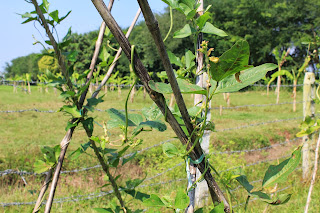On the Koh Rumdual Island (a
river island) in the Kandal Province there are two extremely different
communities that exist, side-by-side, along the banks of the river. This island
has a gruesome history, having been a former Killing Field location of the
Khmer Rouge. Today, 29 October 2013, I had the privilege of visiting these two communities
with Side-by-Side International’s Dr. Rany, Mang Da (SBSI nurse), and with the
Kitihara Clinic’s physical therapist, Yoshi, and nurse, Asuka. We traveled by
moto and tuk tuk for about 30 kilometers to the province, which is located to
the South of Phnom Penh. Outside of Phnom Penh the roads became very bumpy and the
visible poverty became more intense. I saw a boy working at one of the roadside
stores, he was hobbling under the weight of his load and so I looked more
closely because it didn’t appear to be a load of significant size. That is when
I noticed that protruding from below the hem of his shorts this boy had two
wooden legs. I felt a twinge of shame when I recalled how many times in recent
years I have wished to be able to run again, but the pain from the arthritis in
my hips has stopped me from doing so. I really have nothing to complain about.
 |
| Yoshi and Asuka in the tuk tuk |
Riding in the tuk tuk we
approached a small town and although it is a national holiday today there were
children in the school there. I saw two young boys (probably about 8 years
old). One was riding a moto and his friend was riding a bike (“cong” in Khmer),
but the boy on the bike had his right arm extended and he was gripping onto the
seat bar of the moto, being towed along to school. There were chickens, dogs,
and even cows roaming free along the side of the road. As we left the town and
neared the province I saw massive fields, but they were flooded. The water
damage from flooding this year has been particularly damaging. We stopped the
tuk tuk by a roadside fruit stand to wait for the Side-by-Side staff who were
traveling by moto. Next to the fruit stand there stood a tall tree next to a
Lilly pond and hanging from both sides of the tree were wooden seated swings.
As we perused the fruit stand three young children, two boys and a girl,
appeared. I smiled at them and motioned toward the swings. The girl began to
climb into the swing and the other (perhaps he was her older brother) then got
into the other swing, while the youngest child, who was naked, just watched. Their
joy was priceless.
 |
| Flooded field |
The moto with Side-by-Side staff
arrived and we continued the journey. Just five minutes down the road we pulled
over by the side of a river where we got onto a boat to cross the river. I
write “onto” the boat, not “into” the boat because it was really more like a
raft – consisting of two wooden canoes attached together by a wooden platform
that laid across the top of the canoes. Rudders were attached to the sterns of
each of the canoes and these are connected together by a cross bar that the
pilot steered with his right foot, while also controlling a long-shaft outboard
motor that he started with a hand crank. There was a fairly swift current in
the river and I was impressed by our pilot’s steering ability.
 |
| The boat |
 |
| The entrance to Side-by-Side School from the river |
We spent a couple of hours walking
from one community to the other and speaking with some of the residents. On the
right side all of the residents take great care to clean up the clutter that daily
builds around their homes. There are no heaps of garbage. There are clean, safe
fields for the children to play in. The children are healthy and happy. On the
right side of the river there are healthy, productive fruit trees and vegetable
crops that supply food for the families and the food that they do not eat
themselves is sold for profit at the market. The people who live on the right
side of the river also have learned how to rotate their crops so that they have
a continual harvest throughout the year. This year when the floods overtook
their pea stands they actually figured out how to use the flooding to significantly
increase their netting of fish. Because the people on the right side embrace
innovations like these they not only have a constant supply of healthy foods to
feed themselves, but they also have increased profit from the sale of their
harvest at the market. Their gardens and fields would be the envy of many. Today
we saw: mango, pineapple, papaya, banana, lime, peas, and lettuce. The parents who
live on the right side also value their health and their children’s health.
They take their children to the medical clinic for regular check-ups and they
also know how to provide basic health self-care (basic diagnosis and
treatments). Their children are learning and growing in ways that will give
them great opportunities to be successful adults.
 | ||||
Yoshi, Asuka, Dr. Rany
A home on the right side
|

Home on the left side
 |
| Children playing on the left side - no adult in sight |
As I write this I realize how
personal this vision of “one healthy city by the river” is to me. My family
name is “Ichikawa”, which translates “one city by the river”.









.jpg)
.jpg)
.jpg)
.jpg)
.jpg)
.jpg)
.jpg)
.jpg)
.jpg)
.jpg)
.jpg)
.jpg)
.jpg)
.jpg)
.jpg)
.jpg)